Passereau aussi commun et répandu que le merle noir , de taille moyenne (longueur : 23 cm ; envergure : 33-36 cm).La tête et les parties supérieures sont brunâtres sans sourcil ou dessin marqué.
Grive Musicienne
Adulte
Grive Musicienne
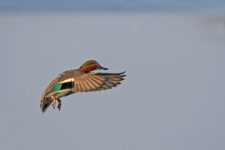
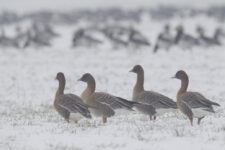
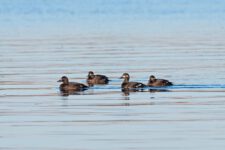
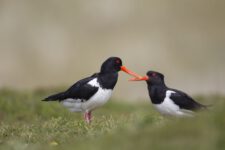
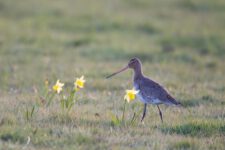
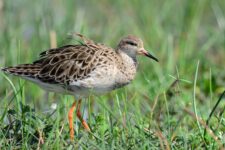
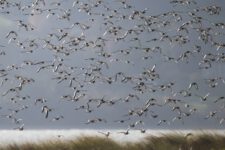
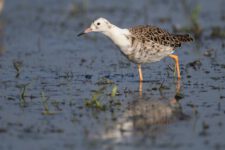
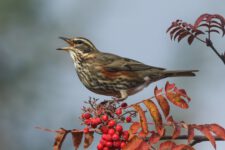
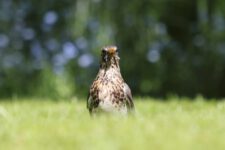
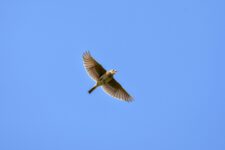
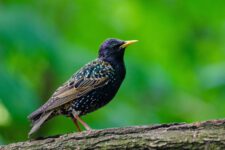
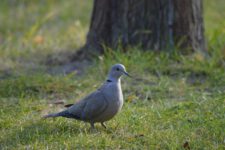
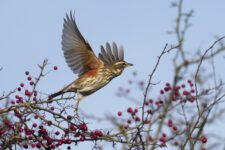
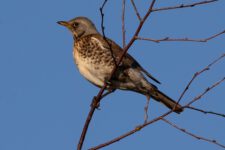
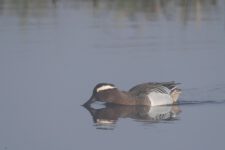
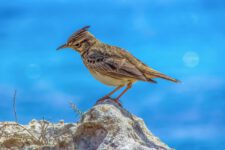
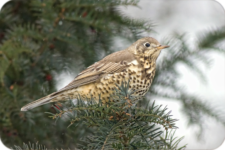
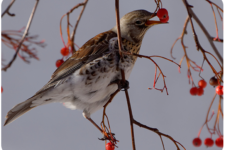
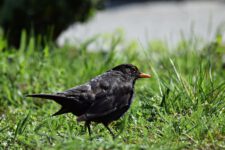
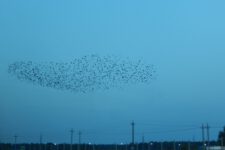
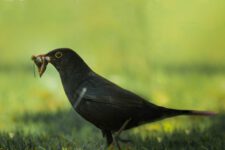
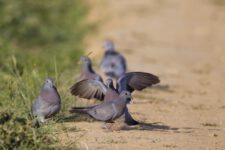
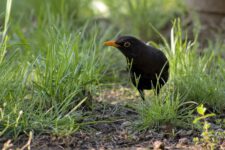
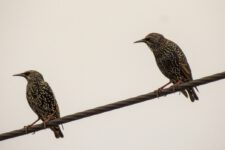
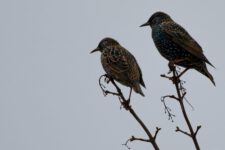
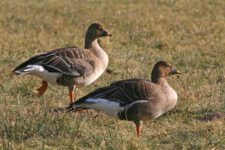
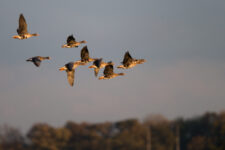
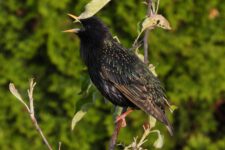
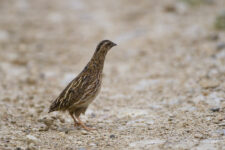
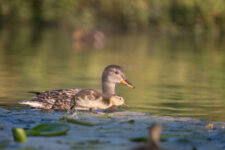
Fiche technique réalisée par Jean Claude Ricci directeur de l’IMPCF
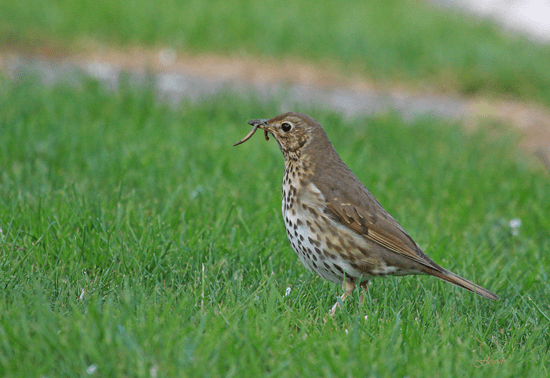
Photographié par : Florian Weber
Espèce : Turdus philomelos (Brhem.1831) : Grive musicienne-Song Thrush-Zorzal comùn-Tordo bottaccio
Directive 79/409 : Annexe II-2
Convention de Bern : Annexe III
Convention de Bonn : Annexe II
Etat de conservation en Europe : SPEC : catégorie 4 (favorable)
Statut en Europe : Sécurisé
Description et Identification
Passereau aussi commun et répandu que le merle noir , de taille moyenne (longueur : 23 cm ; envergure : 33-36 cm).La tête et les parties supérieures sont brunâtres sans sourcil ou dessin marqué. Les parties inférieures sont blanchâtres sur la poitrine avec des taches noires (grivelures) s’étendant sur les flancs. Les deux sexes sont identiques. On admet de légères variations géographiques en distinguant 3 races : T.p.philomelos -T.p.clarkei et T.p.hebridensis.
Le poids varie selon les saisons : T .p.clarkei : 69-101g janv-fév ; 68-96g : mars-avril et 75-107g : nov-déc ; T.p.philomelos :62-77g : mars ; 61-100 :sept-oct ; en migration : 50-83g. Il n’est pas noté de différence significative de taille dans le Paléarctique occidental. T.p.hebridensis (Îles Hébrides) est considérée comme plus sombre que T.p.clarkei. . Les autres oiseaux britanniques et ceux des parties adjacentes du continent (clarkei) ont une coloration moins soutenue mais sont nettement plus roux que la race type (philomelos) qui habite le reste du Paléarctique occidental et qui est davantage brun grisâtre.
Selon (3) : planche 74.
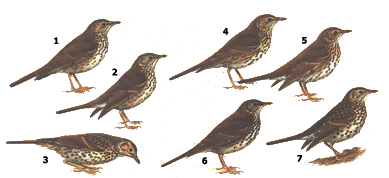
Turdus p.philomelos : 1 = Adulte (printemps) : 2 = Adulte (1er automne) : 3 = Juvénile.
Turdus.p.clarkei : 4 = Adulte (printemps) : 5 = Adulte ( 1er automne).
T.p.hebridensis : 6 = Adulte (automne) : 7 = Juvénile.
La voix : les cris, notamment en migration sont relativement discrets, le plus fréquent est un «tsic «métallique ou un «tsip «émis en vol. Le cri d’alarme est un « tcheuc-tcheuc «répété. Le chant nuptial (émis de mars à août) est une série de phrases mélodieuses et musicales répétées, trois ou quatre fois. Cette répétition est une caractéristique de l’espèce. L’espèce imite facilement d’autres passereaux et non passereaux (Charadriiformes).La fréquence moyenne du chant se situe à 3.8 Khz et le répertoire comprend les plus hautes valeurs du genre Turdus avec la grive litorne. Les jeunes émettent un cri caractéristique de demande de nourriture («tschiptschiptschip «).
Répartition Géographique
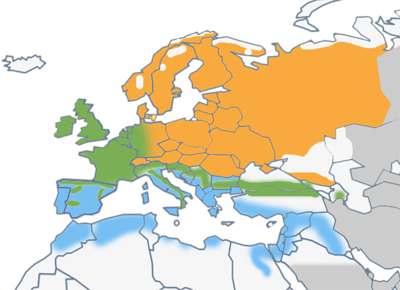
 : Espèce présente toute l’année
: Espèce présente toute l’année
 : Présente en été
: Présente en été
 : Hôte hivernal
: Hôte hivernal
Répartition géographique des «sous-espèces ou races « : T.p.hebridensis est présente dans les îles Hébrides, ouest de l’Ecosse, Arran et County Kerry dans l’ouest de l’Irlande. Sédentaire mais des déplacements vers le sud-sud ouest sont observés en hiver. T.p.clarkei est localisée aux autres zones britanniques (non occupées par T.p.hebridensis), en Irlande et dans les parties adjacentes du continent (ouest et nord ouest de la France, Belgique, ouest et centre des pays Bas). Il est probable que les oiseaux présents au Danemark, dans le centre de la France, en l’Allemagne, en Italie et ceux du nord de l’Espagne et de la Grèce, de Bulgarie et de Roumanie, appartiennent à un » race » intermédiaire entre clarkei et philomelos. Nombreux sont ceux qui se déplacent au sud en hiver pour rejoindre la France, la Corse, le nord de l’Espagne, le Portugal et les Baléares. T.p.philomelos occupe partiellement le centre et l’est de l’Espagne et l’extrême nord est du Portugal, de l’est au sud de la France, la Suisse, les Apennins jusqu’au sud de l’Italie, à l’est jusque la partie occidentale de la Turquie. Au nord, l’espèce philomelos est présente dans les pays scandinaves et à l’est, jusqu’au Lac Baïkal, sud ouest du Caucase et au sud de la mer Caspienne. Cette race a été introduite en Australie, dans l’île Lord Howe et en Nouvelle Zélande où elle est désormais commune.
Détermination de l’âge et chronologie de la mue : Les adultes muent après l’élevage des jeunes soit de mi-juin à août. Les jeunes débutent la mue après l’envol du nid qui se termine entre juillet et septembre. Les critères de détermination de l’âge en automne reposent essentiellement sur l’examen des plumes de l’aile (couvertures et rémiges) et des rectrices
Jeune
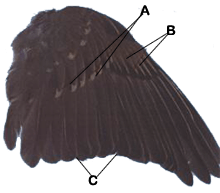
A : Extrémité des grandes couvertures avec une tâche blanche triangulaire
B : Couverture primaire plus longue avec contraste marqué
C : Extrémité des rémiges arrondie et non défraîchie
Jeune
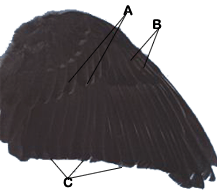
A : Couleur uniforme des grandes couvertures et tâche moins visible que chez les jeunes.
B : Couverture primaire longue moins contrastée
C : Extrémité des rémiges usées et défraîchies
Habitat et Alimentation
Espèce commune et localement abondante. Elle affectionne les habitats boisés, les zones à sous-bois dense, des forêts aux parcs et jardins pendant la reproduction. Elle utilise plutôt les milieux plus ouverts pendant l’hivernage (matorrals et garrigues méditerranéennes, haies, bords de ruisseaux et zones cultivées particulièrement les vignobles). La grive musicienne a bénéficié des transformations des systèmes de cultures, la généralisation de parcs et jardins plantés d’arbustes d’ornement souvent porteurs de baies. Elle évite les zones les plus froides et les plus chaudes pour la reproduction (bordure côtière méditerranéenne).La présence d’escargots et de lombrics est un des facteurs favorisant l’espèce. La grive musicienne recherche sa nourriture sous les arbustes et les arbres, dans la litière, comme le merle noir et se distingue par ce comportement des 3 autres espèces de grives chassables en europe.
Elle consomme la plupart des invertébrés (mollusques, insectes, arachnides, myriapodes, annélides notamment lombrics) mais aussi des fruits en automne et en hiver : baies des arbustes (juniperus, rubus,sorbus, cotoneaster, hedera, etc, raisin, olives …). Quelques cas de consommation de petits vertébrés ont pu être notés : lézards, musaraignes…
En Grande Bretagne , l’analyse de 84 estomacs récoltés toute l’année a révélé la présence de : 35.5% d’insectes, 15% de lombrics , 5% d’escargots , 1.5% d’autres invertébrés, 41.5% de fruits et de baies et 1.5% de plantes herbacées En Espagne (Cordoue) , le régime hivernal est surtout composé de fruits (69-82% de matière végétale) ; 41-60% d’olives et d’invertébrés (escargots et coléoptères) .Dans le désert du Négev (Israël) , la grive musicienne exerce une forte pression de prédation sur les escargots et sur certaines espèces en particulier. La grive musicienne est capable d’utiliser un » outil » pour se nourrir. Elle projette violemment l’escargot sur une pierre ( » enclume « ) pour briser la coquille.
Les programmes forestiers de reboisement devraient inclure un vaste choix d’espèces végétales productrices de baies pour favoriser l’espèce. La restauration ou la plantation d’oliveraies encouragées par l’Union européenne constitue un facteur favorisant l’espèce de même que la déprise agricole transformant des parcelles cultivées en friches favorables à l’espèce.
Reproduction
La reproduction (ponte) débute en mars en Europe de l’ouest, à la mi-avril en Europe centrale et de l’est et en avril-mai en Finlande. En Nouvelle Zélande, la ponte s’étend de fin juin à mi-décembre.
Le nid est construit par la femelle dans les arbres ou les arbustes en règle générale mais quelquefois au sol, dans un talus couvert de végétation dense. En Pologne, les mesures de 196 nids ont permis d’établir la moyenne à 2.5m au dessus du sol (0-8). Le nid est fait de brindille et de paille, tapissé de mousse, de feuilles et d’herbes, le tout consolidé avec de la boue. Les dimensions suivantes ont été observées en Pologne : diamètre extérieur : 14.8cm (9.3-18) ; diamètre intérieur : 9.1cm (8.0-13.0) ; hauteur : 11.7cm (7.5-23).
Les œufs sont rarement unicolores sans tache, lisse, luisant, bleu pâle avec des taches brunes, rousses ou noires.(Selon 3 planche 84).

Populations
Une synthèse européenne récente (4) a estimé les effectifs européens de couples nicheurs entre 12 et 25 millions ( 36 pays concernés).En France , les effectifs se situent entre 400 000 et 2 millions de couples , en Espagne entre 200 000 et 400 000 couples , en Italie , 100 000 à 300 000 couples , Grèce : 2000 à 5000 , Portugal : 10 à 100 couples. Parmi les pays concernés, les effectifs les plus élevés se situent en Allemagne (1.7 à 5 millions de couples) , Suède (1.5 à 3 millions de couples) , Lituanie (1 à 2 millions) et Royaume Uni (1.1 million de couples).
Une synthèse européenne récente (4) a estimé les effectifs européens de couples nicheurs entre 12 et 25 millions ( 36 pays concernés).En France , les effectifs se situent entre 400 000 et 2 millions de couples , en Espagne entre 200 000 et 400 000 couples , en Italie , 100 000 à 300 000 couples , Grèce : 2000 à 5000 , Portugal : 10 à 100 couples. Parmi les pays concernés, les effectifs les plus élevés se situent en Allemagne (1.7 à 5 millions de couples) , Suède (1.5 à 3 millions de couples) , Lituanie (1 à 2 millions) et Royaume Uni (1.1 million de couples).
Une synthèse européenne récente (4) a estimé les effectifs européens de couples nicheurs entre 12 et 25 millions ( 36 pays concernés).En France , les effectifs se situent entre 400 000 et 2 millions de couples , en Espagne entre 200 000 et 400 000 couples , en Italie , 100 000 à 300 000 couples , Grèce : 2000 à 5000 , Portugal : 10 à 100 couples. Parmi les pays concernés, les effectifs les plus élevés se situent en Allemagne (1.7 à 5 millions de couples) , Suède (1.5 à 3 millions de couples) , Lituanie (1 à 2 millions) et Royaume Uni (1.1 million de couples).
Une synthèse européenne récente (4) a estimé les effectifs européens de couples nicheurs entre 12 et 25 millions ( 36 pays concernés).En France , les effectifs se situent entre 400 000 et 2 millions de couples , en Espagne entre 200 000 et 400 000 couples , en Italie , 100 000 à 300 000 couples , Grèce : 2000 à 5000 , Portugal : 10 à 100 couples. Parmi les pays concernés, les effectifs les plus élevés se situent en Allemagne (1.7 à 5 millions de couples) , Suède (1.5 à 3 millions de couples) , Lituanie (1 à 2 millions) et Royaume Uni (1.1 million de couples).
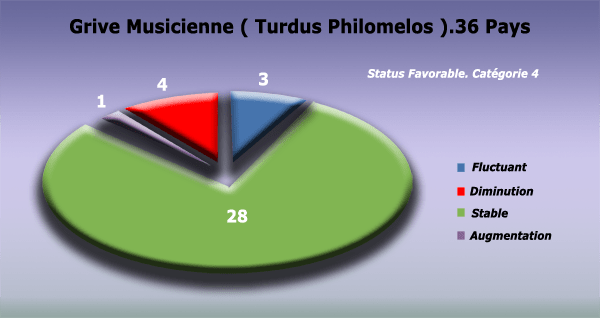
Taux de mortalité : La mortalité au cours de la première année est 53% et de 40% dans la deuxième année (Grande Bretagne). En Finlande, la mortalité totale annuelle est estimée à 54%. Le plus vieil oiseau bagué connu était âgé de 13 ans et 9 mois.
Mouvements dans le Paléarctique Occidental
L’espèce comporte de nombreuses populations résidentes mais les plus nordiques sont partiellement ou exclusivement migratrices. Au contraire de la grive mauvis ou litorne, la grive musicienne témoigne d’une réelle affinité pour les mêmes zones d’hivernage fréquentées chaque année. Les oiseaux originaires de Scandinavie, d’Allemagne, de Suisse, de Pologne et de Russie, migrent vers le sud-ouest et le sud-est de l’Europe pour hiverner au sud de l’Angleterre, en France, en Espagne et au Portugal. Les populations plus nordiques et notamment les oiseaux de première année hivernent plus au sud : Îles Canarie, Maroc, Algérie, Tunisie, Lybie et Chypre. Les oiseaux provenant du Danemark, des Pays Bas, de Belgique, et du nord-est de la France sont partiellement résidents ou se déplacent sur de courtes distances vers le sud. Les oiseaux provenant de Suisse, migrent vers le sud de la France, le long de la côte méditerranéenne, au nord de l’Italie, en Corse et en Lybie. Les reprises d’oiseaux bagués en Grèce révèlent une origine Scandinave, de Russie occidentale mais aussi d’Italie et de Malte. Les populations les plus orientales hivernent probablement de la méditerranée occidentale à l’Iran, Koweit et Erithrée.
De nombreux oiseaux originaires de Grande Bretagne et d’Irlande hivernent au nord-ouest de la France, au nord de l’Espagne, au Portugal et aux Baléares mais aussi probablement en Algérie.
Les oiseaux migrant de nuit sur la mer du Nord sont fréquemment victimes des torchères des plates formes pétrolières off-shore et des projecteurs des phares. Les départs en migration en automne débutent en septembre mais aussi en août. Les stations bioacoustiques installées en Lombardie (IMPCF : 11, 12, 13, 14) détectent des déplacements dès la troisième semaine de septembre ce qui est confirmé par les captures de la station de baguage d’Arosio (Italie.FEIN).La grive musicienne débute la migration post nuptiale (septembre-octobre) avant les grives mauvis et litornes (fin octobre-novembre). Les oiseaux originaires des parties septentrionales de l’Europe (Scandinavie, Sibérie..) débutent leur migration en septembre alors que ceux plus au sud (Allemagne, Belgique, Suisse …) commencent à migrer en octobre-novembre. Cette succession des passages selon les origines des oiseaux a été bien étudiée, tant au cours de la migration post nuptiale que pré nuptiale, par les stations bioacoustiques (cf : IMPCF : 6 ; 8 ; 9 ; 10-14 et ONCFS : 15) qui fonctionnent donc toutes les nuits de septembre à début mai.
Le départ en migration pré nuptiale des oiseaux hivernant en Afrique du nord débute de fin mars et se poursuit jusque mi-avril (3) de même en Ukraine et dans le Caucase. C’est à cette période que les oiseaux quittent aussi leur zone d’hivernage située au Portugal, Espagne et sud de la France. Ces résultats ont été confirmés récemment tant par l’utilisation de stations bioacoustiques et de dénombrements hebdomadaires (5) que par l’analyse de l’accroissement lipidique (4). Ces résultats sont en outre confirmés par les dates d’arrivée sur les sites de reproduction tant en Europe centrale qu’en Europe du nord (3 ; 16). La grive musicienne est parmi les 5 espèces chassables du genre Turdus à terminer le plus tard la migration de retour soit au cours de la première décade de mai (3; 12 ; 13).
Comme le merle noir, la grive musicienne a un comportement plus grégaire en migration (post et pré nuptiale) qu’elle n’en témoigne pendant l’hivernage. Ce critère a été retenu dans le protocole de dénombrement utilisé dans le sud de la France (IMPCF : 10) pour définir avec plus de précision le début de la migration.
Chasse-gestion des Populations et des Habitats
La grive musicienne est parmi les espèces du genre Turdus dans le Paléarctique occidental la plus chassée notamment dans les Pays méditerranéens (Chypre, Espagne, France, Grèce, Italie, Malte, Portugal). Dans ces pays la chasse est pratiquée depuis l’antiquité selon des procédés traditionnels, avec ou sans appelant, mais aussi au fusil, devant soi ou à poste fixe. Dans le sud est de la France et en certaines régions d’Espagne, la capture de cette espèce à la glue est autorisée par dérogation à la directive 79/409 (article 9). Aux Baléares, la même dérogation est accordée pour l’utilisation des filets ( » filats « ). Dans tous les cas le critère retenu est » la capture en petite quantité » de nature à ne pas nuire à l’état de conservation de l’espèce. Rappelons que celle-ci est considérée actuellement en état de conservation favorable dans une synthèse européenne récente (4).
Les prélèvements réalisés par la chasse à tir en Europe sont insuffisamment connus et mériteraient de faire l’objet d’une méthodologie commune. Par sondage aléatoire (Sofres), les prélèvements nationaux des quatre espèces de grives (musicienne, mauvis, litorne et draine) ont été estimés en France (ONCFS-UNFDC) en 1998/1999 à 4 537 960 (± 1.8%). Ce chiffre, si l’on se réfère à l’estimation des effectifs européens avant le départ en migration, calculé en considérant la production moyenne de deux jeunes par couple (6), représente 1.4 à 1.6% de la valeur médiane du total européen estimé.
L’instauration d’un carnet de prélèvements ou d’un suivi annuel par enquête comme établi en Italie et en Grèce, permettrait une surveillance annuelle alors que les enquêtes nationales en France sont réalisées tous les dix ans en moyenne ce qui interdit toute comparaison pour un groupe d’espèces migratrices dont le niveau de migration et d’hivernage est largement tributaire des conditions météorologiques annuelles.
La conservation des habitats de reproduction mais aussi d’hivernage et de halte migratoire est un des éléments essentiels du plan d’action en faveur de cette espèce. L’axe nord-sud constitue un maillon indissociable de conservation : gestion des habitats au nord et gestion des populations et des habitats au sud. Parmi les mesures essentielles de gestion des habitats ont peut citer la conservation et la multiplication des haies selon des critères bien définis ( strates arbustives et arborées développées) , intégration d’arbustes à baies dans les plans de reboisement , gestion des friches issues du gel des terres , conservation d’une mosaïque de » milieux fermés-milieux ouverts » dans les matorrals et garrigues en zone méditerranéenne devant trouver un compromis avec les actions de prévention des incendies.
Le développement de la culture de l’olivier soutenue financièrement par l’Union européenne devrait être à terme un facteur favorisant l’espèce en zone d’hivernage mais aussi pendant la migration de retour (haltes migratoires) assurant aux oiseaux la possibilité de constituer les réserves nécessaires à leur long voyage et probablement devant améliorer leur survie avant la reproduction.
































